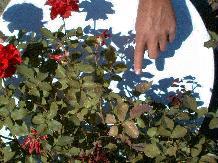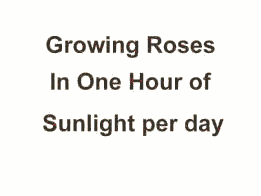
| Home | Products | Exhibits |
| Store | Overview | Application |
| Links | Brochures | Contact |
| MSDS |
Roses Treated at Mt. Saint Michaels
What our customers are saying about BioVam Mycorrhiza and Roses.
Dear Thomas,
"We have about 50 members right
now and about 30 of them come to our regular monthly meetings. We are having
our November meeting on Wed, Nov. 23, 1999, and I will talk to them about
sending you info on how BioVam is working for them. I have shared the info
with the officers and got them to try it. I guess we wanted to see for
ourselves before we promoted it to the whole society.
The bottom line is it works
and, with your help, I would love to share the news with everyone."
Thanks. ---
Terry Ellis, President,
Raleigh North Carolina Rose Society
The Pensacola Florida Rose Society has written a lengthy article on BioVam. Click here to read the article.
The owner of Sherando Roses, Randy De Trinis, located in Lyndhurst, VA, has treated all of his nursery Rose plants with BioVam. Randy says they are clear of powdery mildew and the only leaves that had any black spot were those that were frozen in a late frost in March 2000. The rest of the plant remains free from black spot. Randy also stated there is a significant difference in the number of buds on his Rose plants. Normally they average 7 to 9 buds per plant. After treating all his Roses with BioVam, the average bud count per plant was around 22. If you are looking for nice healthy Roses or want to know more about how he feels about our BioVam product, give him a call or send him an email.
Randy says about BioVam, "It is by far the best thing for roses I've ever used." Click here to read Sherando Roses December 2000 Newsletter.
Mount Saint Michaels a national historical landmark North East of the City of Spokane has Roses growing in areas affected by shade from several different kinds of trees. This customer uses BioVam, Biosol Forte 7-2-1 fertilizer, Rock Phosphate and Ironite minerals on their Roses.
Usually, when mildew forms on the leaves of a rose plant, it will travel over the rest of the leaves until the whole plant is covered with mildew. BioVam applied to the roots of this Rose has made a significant difference.
When Roses at this customer's site were treated with BioVam, the mildew, which was on the plant at the time of treatment, did not spread to the other leaves on the plant. BioVam Mycorrhiza worked in the plant's root system to raise the level of vitality and vigor of the Rose plant to the point where it would not allow mildew to get a foothold on the healthy leaves.
Click on Picture to enlarge.
This rose plant was treated with BioVam after it had grown about 14 inches. It grew another 14 inches with significant new growth after BioVam was applied to its' roots. The bloom came out on the new growth after BioVam was applied. As soon as one bloom finished, more blooms were starting up.

At this location, Roses always died in the past. There wasn't enough light and pine tree roots monopolized the soils. We treated this Rose with BioVam and it proceeded to put on buds and bloomed. About one hour per day of direct sunlight reaches this plant. This plant started blooming July 15. The conditions have certainly slowed the plant down. The experiment demonstrates that BioVam can make a significant difference with Roses that are not doing well because of lighting conditions.
BioVam treated Miniature Roses grow with little sunlight.
These miniature Roses (above) are planted along the east side of the owners home. There is a house close by to the east, which blocks the morning sun. There is a tall Maple tree to the south that blocks the noontime sun. I've been trying to find when the sun is shining on these Roses. It can't happen after 7 am because I've been there from that time to late afternoon and there wasn't any way for sun to reach those plants then. In 1998 these Roses were doing poorly and one plant died. After applying BioVam to these Roses the Spring of 1999, they have flourished and bloomed steadily. The owner also takes cuttings from these Roses and pins them on her clothing. They have been lasting all day long without wilting. All plants treated with BioVam have a higher amount of water in them and take a lot longer to dry out.
Customer comments:
"I applied BioVam to the roots of my Roses in the spring. After two months, total strangers were knocking on my door to tell me how beautiful my Roses looked." -V.B. Spokane, Washington
"I applied BioVam to my first year Rose plants. Powdery mildew which was on those plants did not spread to the leaves in the new growth that came on after applying BioVam." -R.J. Ninemile Falls, Washington
The Roses above are in their second year under the influence of BioVam. They are Hybrid Tea - Double Delight. The largest bloom is two weeks old as of 6-2-2000 and is 6 inches wide. The plant is starting the year with 15 buds on it. The leaves are nice and dark green, but a bit beaten up from several hail storms this spring. No mildew, blackspot or destructive insects. We water via an overhead sprinkler. The colors are vibrant this year!
Click on pictures above to enlarge.
These yellow English Roses given to me last year are also doing wonderfully under the influence of BioVam mycorrhiza. Pictures Taken: 06-10-2000
Please see our protocol on Roses for proper care and maintenance of Roses treated with BioVam?. Our protocol explains how to maintain the highest levels of Mycorrhizae in their root systems, and how to apply BioVam Mycorrhiza and Biosol Forte 7-2-1 fertilizer to your Rose plants.
Application schedule for Roses
Roses already in the ground: One quart of BioVam will treat 96 rose plants at 2 teaspoons each. Each Rose plant will require 1.5 cups of Biosol Forte 7-2-1 fertilizer at least once per year. 96 Rose plants will require 48 pounds of Biosol Forte 7-2-1 fertilizer.
Roses to be planted: One quart of BioVam? will treat 128 new Rose plantings at 1.5 teaspoons each. Each Rose plant will require 1.5 cups plus 2 tablespoons of Biosol Forte 7-2-1 fertilizer. 128 new Rose plants will require 70 pounds of Biosol Forte 7-2-1 fertilizer.
Typical benefits found in Roses treated with BioVam and our Organic fertilizer.
Our two products do more than give the Rose grower a "competitive edge." They cause your plants to maximize their health and beauty.
Deep and extensive plant root systems.
A much higher level of overall vitality and vigor.
Because of higher vitality and vigor, diseases have a much harder time getting started.
Because of higher vitality and vigor, destructive insects tend to leave the plants alone.
The need for fungicides and pesticides is greatly reduced.
The soil around the plant stays loose and soil microbial activity benefits the Rose with higher levels of nutrient flow into the plant.
The plant becomes much more resistant to environmental stresses - too hot, cold, to wet or dry, not enough sun, etc.
The plant is isolated from the effects of pH imbalances and from environmental hazards.
The Endomycorrhiza in BioVam becomes part of the Roses root system and brings in nutrients and water out of reach of the roots of the plant.
The level of phosphorus in the fertilizer is low, but with Endomycorrhiza in the roots of the Rose, the levels of phosphorus in the Rose plant is four times higher than in plants without Endomycorrhiza in their root system.
Cuttings taken from BioVam treated plants take a lot longer to dry out and wilt because these plants retain water longer than do plants not treated with BioVam?.
We have microscopic pictures on our web site that shows much healthier and larger internal structures in the phloem sieve tubes and xylem vessels inside the plant stems. The cell structures of the outer layers of the plant are much better developed and keep in moisture while preventing diseases from gaining a foothold.
Typical experiences from some of our Customers using BioVam Mycorrhiza on Roses
One customer planted miniature Rose plants where only an hour or two of sun was available to the plants. They lost some of their miniature Rose plants. After applying BioVam Mycorrhiza to those Roses, they started producing a lot of blooms and are the healthiest they have ever been in that location.
Another customer is on her third set of cuttings from her Hybrid Tea Roses. This is early July and there will be several more cuttings made from those Roses. Without BioVam applied to those same plants, they produced one cutting per year.
This customer owned miniature Rose plants which did not produce very well before BioVam was applied to them. After BioVam was applied to the Miniature Roses, which are in full sun they're producing a considerable amount of blooms.
Another said their Hybrid Tea Roses were developing blooms well ahead of leaf development.
A customer had planted a Rose hedge and powdery mildew had started up on many of the plants. After applying BioVam? Mycorrhiza to those plants, they doubled their growth. Powdery Mildew did not spread to any of the new growth.
Several customers living in areas of high humidity on the East coast of the US report that Black Spot fungi is staying off their BioVam treated Roses.
In the Fall of 1998, we treated 120 Rose plants at a nearby historical landmark. When we looked at the plants in early July of 1999, we could find no sign of powdery mildew or black spot. The Roses were clear of diseases.
In the Spring of 1998 a customer planted several Hybrid Tea Roses and had them treated with BioVam Mycorrhiza at the time of planting. After two months, his wife wanted the Ross moved to a better location. The roots on the BioVam treated Roses were all deep into the soils. This customer was talking about something like digging to China. The Roots of BioVam treated Roses go much deeper into the soil than in non-treated Roses.
Product Catalogue
Privacy, Return, Refund Policy
Copyright 1998 - by T & J Enterprises. ALL RIGHTS RESERVED.